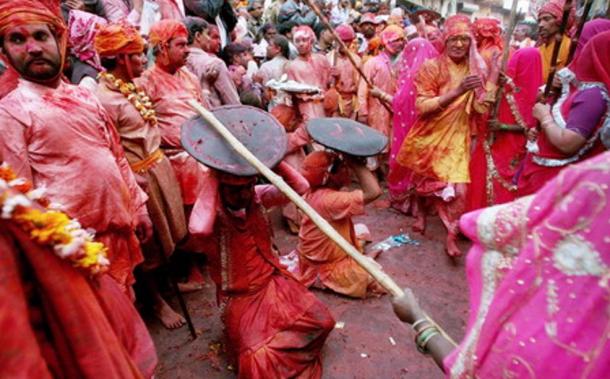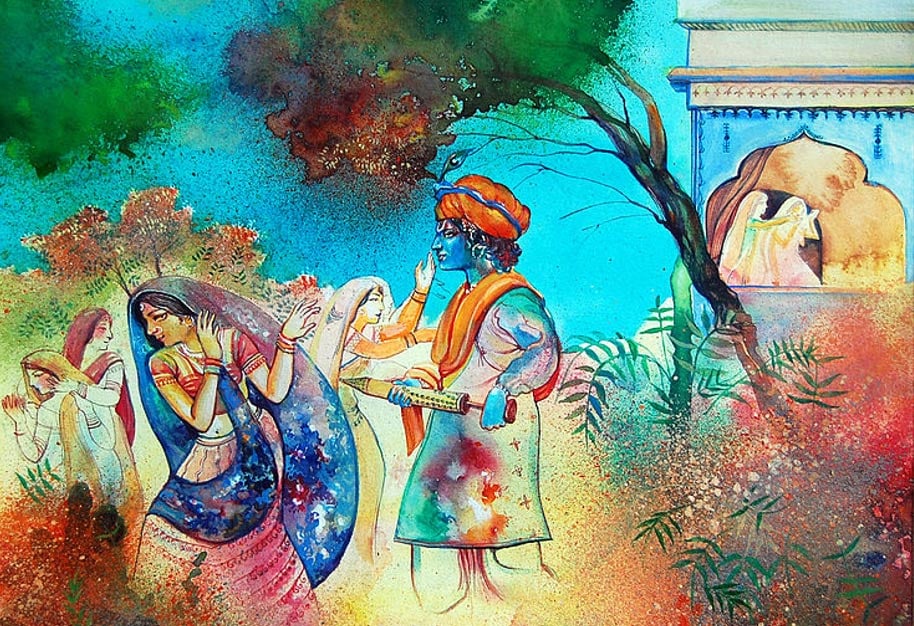Happy Holi: Ancient Legends Behind India's Colorful Celebration
Holi is an ancient Indian spring festival that celebrates love, color, and the triumph of good over evil. Traditionally, this was a major Hindu religious festival in North India, but the fun, vibrancy, unity, and joy associated with Holi has spread to non-Hindus in South Asia and various communities around the world.
The Festival of Colors
The popularity of Holi today may be understood when its other name, the ‘Festival of Colors’, is taken into account. One of the features of Holi is the use of colored powders called 'gulal’ and colored water during the festival. Several days before the celebration itself, markets fill with colored powders of every hue for the festival-goers to purchase. While this is the norm today, there are those who still make the colored powders by themselves, usually from flowers or turmeric, in their homes.
A modern Holi festival celebration, India (Audio Compass)
The vibrant colors of the perfumed powder signify the joy of the arrival of spring and all the new colors blooming in nature. Each of the Holi colors also has a unique symbolism. Red is love and fertility, blue is for Krishna, yellow represents the popular spice turmeric, and green is the renewal of nature and new beginnings. But that doesn’t mean people only throw one color; by the end of the color games most people are walking rainbows of color.
- The Sree Padmanabhaswamy Temple: Secret Cellars Create the Richest Hindu Temple in India
- New Year’s Traditions around the World and Their Origins
- Archaeologists in India Discover Ancient Hero Stones that Retell Epic Battles and Honorable Deaths
Don’t Be Offended, It’s Holi!
The coloring of friends and strangers with powder and water is particularly enjoyed by children. Nevertheless, adults also participate enthusiastically in the color fight that begins in the morning of the festival. Some people also believe that all the singing, dancing, shouting, and play of Holi is good for re-awakening and rejuvenating the body after the long winter.
The color fight seems to be the highlight of Holi and provides us with the most recognizable images of the festival. There is a sense of inclusiveness and joy when everyone’s skin is coated in all the vibrant colors.
In fact, during this celebration, social barriers are broken down, and for a short period of time at least, men and women, young and old, rich and poor, and people of all castes are all on an equal footing. Nonetheless, there are some people who are not too comfortable with this idea, and the saying ‘ buranamano, Holi hai! ’ (‘Don’t be offended, it’s Holi!’) is meant explicitly for them.

In the tradition of “Braj Lath mar Holi” men living in the Braj region of North India must accept whatever women do to them. One of the common acts is for women to playfully hit the men, who protect themselves with shields. Barasana, India. (gkrishna38/CC BY 2.0)
Although the festival of Holi is best known today for its party atmosphere, it also has a religious significance and ancient origins. Holi is referenced in the Vedas, Puranas, and a stone inscription from 300 BC found at Ramgarh. There are also representations of the celebration is sculptures and murals on old temple walls. For example, a temple at Hampi has a 16th century panel depicting a prince and princess about to be drenched in colored water. This is just one of several examples of royalty taking part in Holi celebrations during the medieval period.
The Legend of the Demon King: Good Always Triumphs Over Evil
The Holi festival was originally celebrated within a Hindu context and is still observed on the day after the last full moon of Phalguna, the last month of the Hindu calendar (between late February and early March).
One legend associated with the festival is that of Prahlad and Hiranyakshyap. According to this legend, there once was a powerful demon king by the name of Hiranyakshyap. This demon king resided in Multan and was virtually indestructible, due to a boon granted to him by Brahma.

Hiranyakashipu wielding a mace against Narasimha. (CC0)
Hiranyakshyap grew arrogant, considered himself a god, and demanded everyone worship him. His son, Prahlad, however, was a devotee of Vishnu and refused to worship his father. As a result, Hiranyakshyap asked his sister, the demoness Holika (it is from her name that we get the word ‘Holi’), for her help to get rid of Prahlad. As Holika had received a boon that made her immune to fire, she went into a pyre with Prahlad on her lap, hoping that her nephew would be burnt alive. Prahlad’s devotion to Vishnu, however, saved him, and the demoness was burnt to death instead.
This story is one of the numerous legends associated with the ‘Holika Dahan’ (‘The Burning of Dahan’), a practice that takes place on the eve of Holi, and is also known as the ‘Chhoti Holi’ (‘Small Holi.’) During the ‘Holika Dahan,’ bonfires are lit to commemorate the deliverance of Prahlad from his evil father and aunt. In many parts of India, an effigy of Holika is also burned on the fire. Thus, the ‘Holika Dahan’ is a reminder that good always triumphs over evil.
Women preparing the Holika Dahan bonfire, Kathmandu, Nepal. (CC BY 2.0)
Why Do People Throw Colors at Holi? Thank Krishna and Radha
Throwing colored powders during Holi can be traced back to a legend of Krishna, an avatar of Vishnu. In the story, Krishna felt embarrassed by his dark blue skin and was afraid that the woman he loved, a gopi, meaning cow-herd girl, named Radha would not accept him. The Hindu deity’s mother told him to color Radha’s face a different color, whichever color he wanted. Krishna was extremely delighted in applying color on Radha and the other gopis and this prank later became a part of the Holi celebration.
- Why Christmas is held on 25th December
- The Diwali Festival of Lights: A Celebration of Freedom and Good Triumphing over Evil
- The Mid-Autumn Festival: A Holiday of Mooncakes, Lanterns, Moon Worship, and Timeless Legends

Radha celebrating Holi (1788). (Public Domain)
Radha and Krishna also became a couple, thus throwing gulal during Holi celebrates the immortal love of Krishna and Radha. This explains why some have regarded the festival of Holi in a similar light as St. Valentine’s Day. In Vrindavan and Mathura, two cities deeply affiliated with Krishna, the celebration of Holi is spread over a period of 16 days.
For the rest of the world, however, Holi ends at noon. After cleaning up, people take a bath and relax for the rest of the day. In the evening, they visit friends and family, and exchange sweets, symbolizing forgiveness and a new start.
Top Image: Holi festival celebration. Source: Biswajit Das/CC BY 2.0
By Ḏḥwty
References
hinduism.about.com, 2015. Why Celebrate Holi?. [Online]
Available at: http://hinduism.about.com/od/holifestivalofcolors/a/celebrateholi.htm
National Geographic, 2015. Festival of Colors. [Online]
Available at: http://education.nationalgeographic.com/media/holi-festival/
Society for the Confluence of Festivals in India , 2015. Holi. [Online]
Available at: http://www.holifestival.org/
The BBC, 2009. Holi. [Online]
Available at: http://www.bbc.co.uk/religion/religions/hinduism/holydays/holi_1.shtml
www.indiaexpress.com, 2015. Holi - the festival of colours. [Online]
Available at: http://www.indiaexpress.com/rangoli/holi.html




















Comments
Know more about the festival of colors holi history origin https://goo.gl/6TO60U